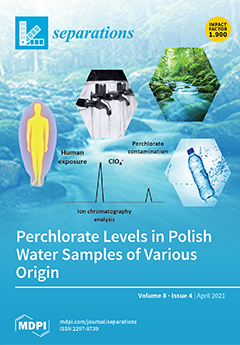This study explored the effects of peanut shell biochar (PSB) on the adsorption capacities of fungicides with and without successive chemical modifications, using KMnO
4 and KOH (PSB
OX-A), in order to provide a valuable understanding of their adsorption mechanisms and behaviors.
[...] Read more.
This study explored the effects of peanut shell biochar (PSB) on the adsorption capacities of fungicides with and without successive chemical modifications, using KMnO
4 and KOH (PSB
OX-A), in order to provide a valuable understanding of their adsorption mechanisms and behaviors. To this end, the physicochemical properties of PSB and PSB
OX-A were examined by using the Brunauer–Emmett–Teller method, Fourier transform infrared spectroscopy, and scanning electron microscopy with an energy dispersive X-ray spectrometer. The effects of temperature, ionic strength, and humic acids on the adsorption of fungicides, using PSB and PSB
OX-A, were estimated through batch experiments. Furthermore, adsorption kinetics, isotherms, and thermodynamics were studied. The maximum adsorption capacities of fungicides by PSB
OX-A were estimated to be more notable (
Qmax of carbendazim = 531.2 μmol g
−1,
Qmax of pyrimethanil = 467.7 μmol g
−1, and
Qmax of tebuconazole = 495.1 μmol g
−1) than PSB (
Qmax of carbendazim = 92.6 μmol g
−1,
Qmax of pyrimethanil = 61.7 μmol g
−1, and
Qmax of tebuconazole = 66.7 μmol g
−1). These findings suggest that successive chemical modification using KMnO
4 and KOH could potentially be used to effectively fabricate PSB to remove fungicides in water-treatment processes.
Full article





